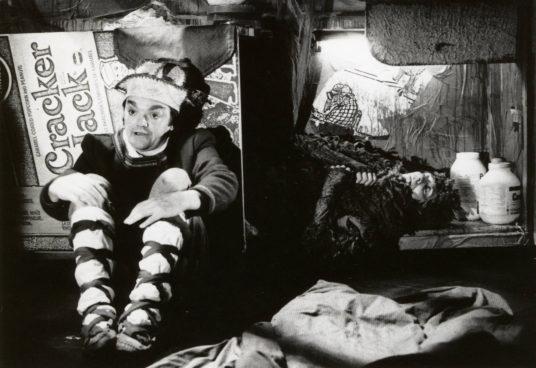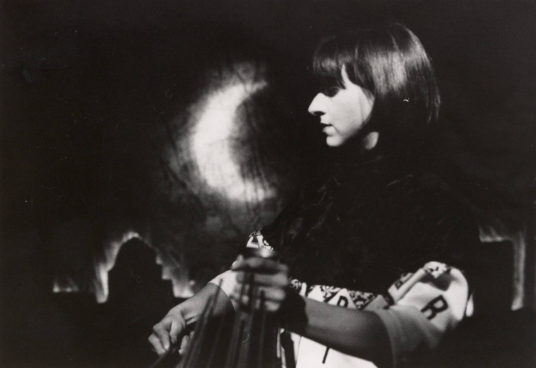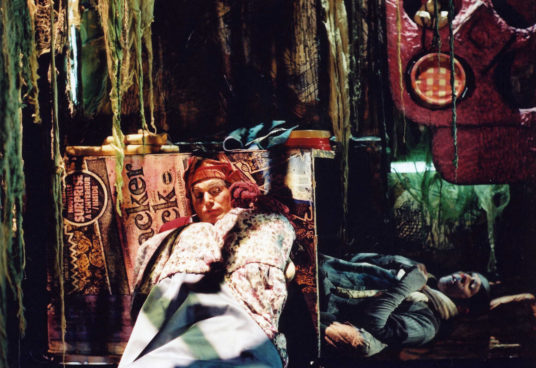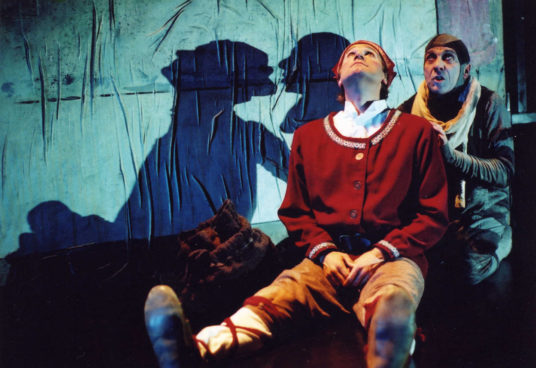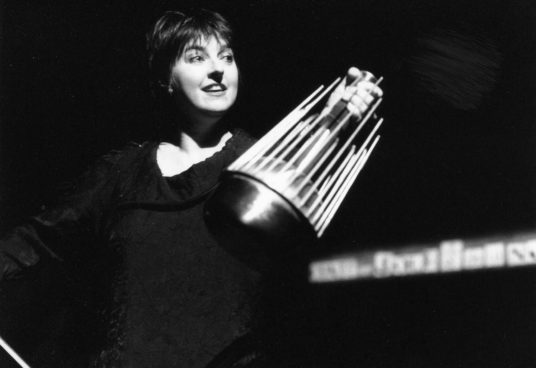A Tale of Day and Night
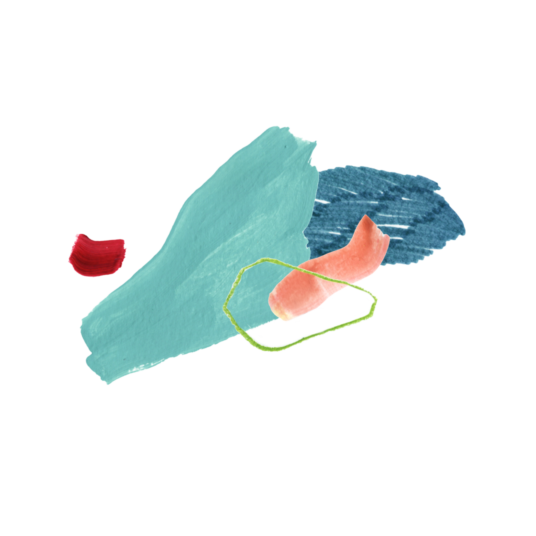
Summary
A tale that begins with “Once upon a time”… a moon … a sun … a city … a rat, Alfredo, and a giant, Troller, turn the pages of time. The images parade by … recounting the first anxious look between the old, cough-racked, complaint-filled rat and the tender, awkward giant … recount the fear and disgust that both repels and attracts them … recount the friendship that blossoms between the two, different as day and night … one so little, the other so big! For his fragile friend who lives in the night, far from people, Troller, in a gigantic gesture, decides to overturn the laws of nature. The images parade by, and they flirt with catastrophe … It is better to leave each other, shedding a tear. The friendship will live in memory.
Text
Suzanne Lebeau
Directed by
Gervais Gaudreault
Assistant to the Director
Roger Gaudet, Robert Vézina
Cast
Linda Laplante (The storyteller, creation), Annick Bergeron (The storyteller), Marie-Michelle Garon (The storyteller), Benoît Dagenais (Troller the giant, creation), François Trudel (Troller the giant), Jean-Guy Viau (Alfredo the rat)
Set design (from an original idea by Pierre Perreault), costumes and props
André Brosseau
Lighting Design
Dominique Gagnon
Sound Design
Diane Leboeuf assisted by Gaétan Leboeuf
Make up and hair
Jacques-Lee Pelletier
Special collaboration
Michel Dupire
Set collaborators
Roger Gaudet et Francine Martin
Creative collaborators
Francine Beaudry, Lisette Dufour
Production director, stage manager, lighting technician
Dominique Gagnon
Sound and set technician
Alexandre Brunet, Éric Gendron
Set construction
Atelier Tact
Costume manufacturing
Gilles-François Therrien
Le Carrousel thanks Annick Bergeron, Benoit Dagenais and Jean Lessard, who have previously been in the cast.
Note: The instrument played by the storyteller is a waterphone. It was created the American multidisciplinary artist Richard Waters.
Translate by John Van Burek, May 1992 : A Tale of Day and Night
“A tender scenic poem in a beautiful book.”
Le Soleil, Quebec city, February 10, 1994
“A profound reflection on humanity.”
La Tribune, Saint-Etienne, France, November 22, 1992
[…] Welcome to tolerance! It unfolds here before enchanted eyes. An outsized fairytale book, a sort of collection of 2D and 3D paintings, serve as a movable and generous set, though ingeniously contained, to serve as the home of Alfredo (he’s the rat) and his gigantic flu pills. They also depict a city, mountains, electric poles the wires between which are used by the giant, Troller, for sewing, and a sun that offers absolutely no cures when it gets unhooked from the sky—not even to heat up the flattened fur of a shivering rat. Everything in its place, according to this fable, which gently points out the difference. The actors play their parts to perfection and the direction is perfectly adapted to the once-upon-a-time nature of its subject. Oh, four- to eight-year-olds are lucky indeed!
La Presse, October 4, 2000
[…] “Conte du jour et de la nuit” is a very solid production, thanks to its 280 performances in Quebec and abroad over almost ten years. It’s not surprising that it’s so effective. There’s never a dull moment, with a sustained pace and high action—a phenomenal example of mastery of the art.oung audiences are very special: they’re not very patient and are easily distracted. To keep them on the edge of their seats, they have to be emotionally involved, laughing a little, dreaming a lot. In the case of “Conte du jour et de la nuit,” this mission is accomplished in every way. When the giant cries like a baby, the entire audience bursts out laughing.
When he sees the rat for the first time and lets out a spontaneous “Ugh!” the children are beside themselves with laughter. Then, when he has to leave his new friend the rat, the audience is moved and empathetic. As for dreams, there is the giant book placed in the middle of the stage, which opens to form different sets: utterly fabulous and ingenious.[…]
Ici Montréal, Week of October 4, 2000
[…] Le Conte ¼ (adapted by Suzanne Lebeau from another of her works, Comment vivre avec les hommes quand on est un géant) is sensitively directed by Gervais Gaudreault. It is obvious that over time, Gaudreault has seamlessly meshed his directing with the poetic scripts by the author for young audiences with whom he founded Le Carrousel 25 long years ago. Under Gaudreault’s direction, there is no hamming it up or excess in the acting. The careful lighting and fantasy-like props add to the quality of this show, produced by a creative team that understands that children can also appreciate the subtleties of theatre!
Voir, October 5-11, 2000
[Translation to come]
Créée en français le 6 décembre 1990 à la Maison de la culture Notre-Dame-de-Grâce à Montréal; et en anglais, le 1er décembre 1994, à la Maison de la culture Mont-Royal.
Awarded the Literary Grand Prize of Journal de Montréal (1991)
| Saison 1990-1991 : 73 représentations | |
| Au Québec : | Montréal (Maison de la culture Notre-Dame-de-Grâce); Montréal (Maison Théâtre – Festival Les Coups de Théâtre); Beloeil (L’Arrière-Scène). |
| Au Canada : | Ottawa (l’Atelier du Centre national des Arts). |
| Saison 1991-1992 : 47 représentations | |
| Au Québec : | Laurentides; Montérégie. |
| Saison 1992-1993 : 42 représentations | |
| En France : | Saint-Étienne; Annecy; Givors; Villeurbanne. |
| Saison 1993-1994 : 15 représentations | |
| Au Québec : | Montréal; Québec (Le Périscope); Drummondville; Gatineau; Valleyfield. |
| Saison 1994-1995 : 50 représentations | |
| Au Québec : | Québec; Hull; Montréal. |
| Au Canada : | Toronto (Young People Theatre). |
| Saison 1995-1996 : 1 représentation | |
| Au Québec : | Montréal. |
| Saison 1996-1997 : 10 représentations | |
| Au Canada : | Ottawa (Centre national des Arts). |
| Saison 2000-2001 : 29 représentations | |
| Au Québec : | Montréal (Maison Théâtre). |
| Saison 2001-2002 : 45 représentations | |
| Au Québec : | Montréal-Nord; La Salle; Saint-Laurent; Pointe-aux-Trembles; Pierrefonds; Saint-Léonard; Sainte-Geneviève; Québec; Granby; Longueuil; Saint-Jean-sur-Richelieu; Valleyfield; L’Assomption. |
| Saison 2002-2003 : 31 représentations | |
| Au Québec : | Villeray-Saint-Michel-Parc Extension; Rimouski; Rivière-du-Loup; Trois-Rivières; Drummondville; Gatineau. |
| Saison 2003-2004 : 20 représentations | |
| Au Québec : | Montréal; Outremont; Châteauguay; Joliette; Alma; Jonquière. |
PUBLICATIONS :
En français : Éditions Leméac, Collection Théâtre pour enfants (Québec, 1991).

